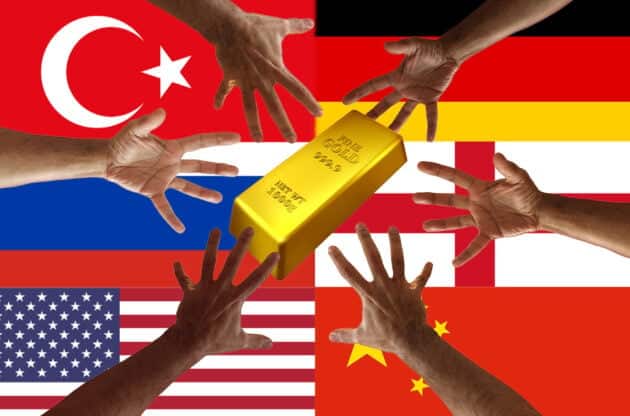For many years, central banks worldwide have stored their gold in more economically stable nations for safekeeping and investment purposes.
But now, due to growing geopolitical tensions and rising global economic concerns, central banks from many countries are pulling their gold out of foreign vaults and bringing it back home fast.
It’s a process called gold repatriation.
And according to data from the annual Invesco Global Sovereign Asset Management Study of 85 sovereign wealth funds and 57 central banks the main reason for their repatriation efforts is clear:
“A substantial percentage of central banks are concerned about the precedent set by the US freezing of Russian reserves”.
So, What Happened to Russia’s Gold Reserves?
In 2022, the United States, European Union and other G7 countries levied sanctions against Russia’s central bank after Russia’s attack on Ukraine. This aggressive move froze Russia’s access to almost half of their $640 billion in gold and foreign exchange reserves. This meant the country lost access to $300 billion in reserves held abroad.
Potentially expanding this effort, a bill was introduced in the U.S. Congress in June to mobilize the seized assets to help fund Ukrainian reconstruction:
Senator Jim Risch declared, “Over a year into Russia’s full-scale war against Ukraine, more than $300 billion in Russian sovereign assets remain frozen globally. Given Russia’s brutality and continued war crimes against the Ukrainian people, it is only right that Russian government funds in the United States be seized and repurposed to help Ukraine rebuild its country,”.
If the bill passes, the U.S. will not only freeze access to another nation’s assets but also reapportion them to help another country.
This very real possibility has many central banks concerned about their status as a potential target for further Western sanctions.
Rob Ringrow, Invesco’s head of official institutions confirmed this concern and said the mantra Invesco has been hearing from central banks for the last year or so is: “If it’s my gold, then I want it in my country.”
It’s a sentiment many countries have held for years:
In 2014, the Netherlands pulled 122.5 tons from the Federal Reserve Bank of New York because “in times of financial crisis, it was better to have the gold near at hand.”
In 2017, Germany repatriated 743 tons of gold from France and the US. And in 2020, they took 940 tons of gold back from the Bank of England.
And now, the trend is picking up steam:
In 2020, 50% of the Invesco survey respondents stored their gold abroad.
That number has risen to 68% in 2023.
And 74% said they plan to recall their gold from Western vaults, like The Bank of England, within five years.
The Bank of England was once a major gold storage hub for international banks, but their holdings have dropped 12% from their peak in 2021 to 164 million troy ounces at the beginning of June.
Speaking anonymously, a central bank from the Invesco survey said, “We did have it (gold) held in London… but now we’ve transferred it back to [our] own country to hold as a safe haven asset and to keep it safe.”
But sanction concerns aren’t the only repatriation trigger. Many central banks also cited inflation as a mitigating factor.
More than 85% of the sovereign wealth funds and central banks surveyed said they believe inflation will not diminish, but instead be higher in the next decade.
Concerned by those headwinds, 96% of survey respondents said they’re increasing their gold investments due to gold’s status as a safe haven.
Per Business Insider: “41% of surveyed central banks and sovereign funds expect to increase gold holdings in the next three years.”
In other words, they’re not only repatriating their gold, but they’re also increasing their reserves.
In February, the World Gold Council reported that central banks around the world bought 1,136 metric tons of gold in 2022. This record amount was a 12th straight year of increased purchases of this precious metal.
The Financial Times noted: “China and Turkey together accounted for almost one-fifth of these purchases.” And: “Other countries that have made significant gold purchases include Singapore, India and central banks in the Middle East.”
And this increased buying has been a key support for global gold prices:
And rising repatriation and central bank gold buying efforts may affect the price of gold.
If multiple central banks and sovereign wealth funds are stocking up on gold and bringing gold home, it means balance of the world’s gold reserves is shifting.
And with a finite supply of gold above ground…
What will happen to the price of gold when the trend intensifies and central bank buying increases?
What will happen to the price of gold when thousands or even millions of Americans realize what’s happening with gold around the world and rush in to fortify their holdings?
Only time will tell.
But it’s a clear signal to Americans that it’s a wise time to consider owning gold or fortifying our holdings while we still can.
————————————————————————————————-
If you’re interested in discovering more about owning gold, request a FREE copy of the new Gold Information Kit. Or call 888-529-0399 to speak with a Gold Specialist . Considering the swift changes happening with gold worldwide, you’ll be so glad you did.
July 20, 2023
How the National Debt Will Impact Current and Future Generations
June 29, 2023
IRS Court Win and New Fed Programs Put Privacy Watchdogs on High Alert
The post Spooked Central Banks Want Their Gold Back NOW appeared first on Gold Alliance.

